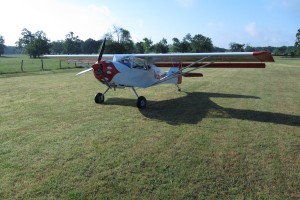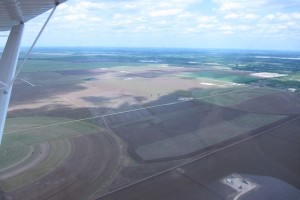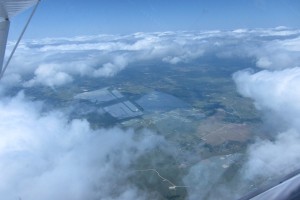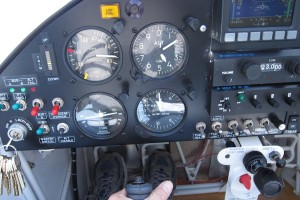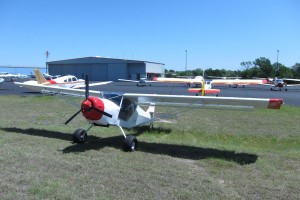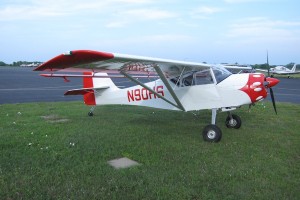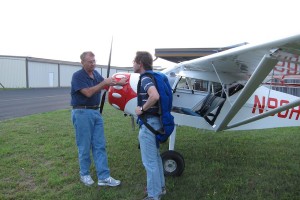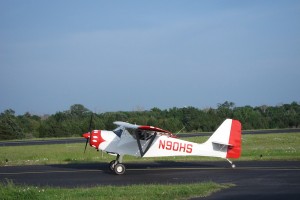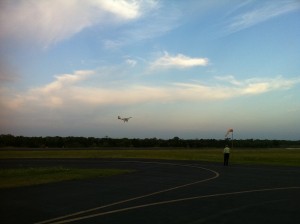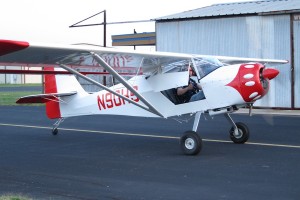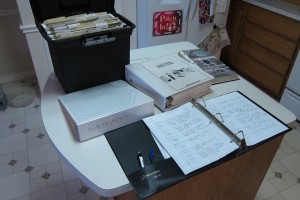I was able to fly last Monday in the morning and Friday both before and after work. Over the weekend I flew Saturday and Sunday. On Saturday I went back up to Hearne in the morning to practice takeoffs and landings and then in the afternoon I flew to Madisonville. A distance of 23 nautical miles. I practiced takeoffs and landings on the narrow 50 foot wide runway and then headed back to Coulter.
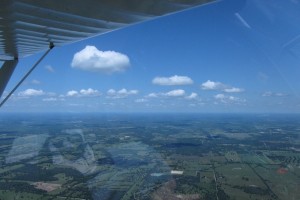 On Sunday morning I slept in as there was fog forecast for much of the area. When I looked out shortly after sunrise I saw blue sky and realized that the forecast was wrong and headed for the airport. I was in the air by about 8:30 and here you can see the view as I headed for an uncharted private airstrip just east of Normangee. I know the owner and have permission to land there. This will be my first landing on grass. A much easier surface to land an airplane of this sort on. Providing the surface is in good shape
On Sunday morning I slept in as there was fog forecast for much of the area. When I looked out shortly after sunrise I saw blue sky and realized that the forecast was wrong and headed for the airport. I was in the air by about 8:30 and here you can see the view as I headed for an uncharted private airstrip just east of Normangee. I know the owner and have permission to land there. This will be my first landing on grass. A much easier surface to land an airplane of this sort on. Providing the surface is in good shape
 This is a view of Scot’s airstrip from pattern altitude of 1000 feet agl. Although there was not enough moisture in the air for the predicted fog there was a scattered layer of clouds at about 700 feet and you can see them here. The runway runs parallel to the long white gravel driveway and just below it in this picture. Final approach is over the pond on the far right and Scot’s hangar and house are at the other end.
This is a view of Scot’s airstrip from pattern altitude of 1000 feet agl. Although there was not enough moisture in the air for the predicted fog there was a scattered layer of clouds at about 700 feet and you can see them here. The runway runs parallel to the long white gravel driveway and just below it in this picture. Final approach is over the pond on the far right and Scot’s hangar and house are at the other end.
 The view on final was beautiful. The sun was still low and some mist was rising off the pond into the sunlight that was coming through the trees. I wish I could have taken a picture but I had to fly the plane. After landing I took these pictures of N90HS sitting on the grass strip in the morning sun. She looks like she belongs there.
The view on final was beautiful. The sun was still low and some mist was rising off the pond into the sunlight that was coming through the trees. I wish I could have taken a picture but I had to fly the plane. After landing I took these pictures of N90HS sitting on the grass strip in the morning sun. She looks like she belongs there.
 While walking around to take pictures I looked back down the runway and saw the tracks I made in the dew. The first part of the runway, just past the pond, is uphill and then the portion shown here is slightly downhill. The top of the hill is by the orange windsock that can be seen behind the fence. I taxied back to the top of the hill and took off and went around a few more times. On the last one I saw that Scot had come out to watch so I shutdown the engine after landing so we could visit. He commented on how fast my airplane gets off the ground and how well she climbs. I hear that a lot. Scot invited me to a fly in fish fry in few weeks that will be held here at his ranch. I took off and flew back to Coulter and my plane was back in its hanger by 10:00
While walking around to take pictures I looked back down the runway and saw the tracks I made in the dew. The first part of the runway, just past the pond, is uphill and then the portion shown here is slightly downhill. The top of the hill is by the orange windsock that can be seen behind the fence. I taxied back to the top of the hill and took off and went around a few more times. On the last one I saw that Scot had come out to watch so I shutdown the engine after landing so we could visit. He commented on how fast my airplane gets off the ground and how well she climbs. I hear that a lot. Scot invited me to a fly in fish fry in few weeks that will be held here at his ranch. I took off and flew back to Coulter and my plane was back in its hanger by 10:00
After lunch I headed up to another grass strip. This one is also private but it is charted so all I had to do was touch it on my gps screen and then select “Fly Direct to Here” from the menu. The distance is 45 nautical miles. Close to the 50 mile limit I am restricted to during my 40 hour test period. I know the owner and have permission to land there. He has built a fly in campground among the pine trees. He calls it “Critter’s Lodge”. The annual fly-in is in two weeks and I plan to have my first taste of fly in camping at the event.
As I flew over the runway I saw a large mower sitting right in middle. So I set up to land but made a low approach over the runway. I was hoping they would see me an move the mower so I could come back around and land. On the next approach the mower was sill there and no one was in sight so I applied power and climbed out and headed off to Hilltop Lakes.
Hilltop Lakes is a rural community that has a paved runway connected to grass taxiways that run behind the homesites. So, you have street in front of your house and a grass taxiway behind your house. This is view looking down one of those taxiways. The paved ramp is in front of a homeowners hangar and there are several other hangars down the length of the taxiway. At the very end, over the left wing is the runway which runs perpendicular to the taxiways. It’s a nice development with several lakes, a large pool, campground and a 18 hole golf course. I know several of the residents and was able to show off my new plane.
I then headed back to Coulter and put her away for the day. I took off some inspection plates just to see how everything is holding up and made an adjustment to the trim system. I don’t have enough nose up trim for approach speed but more nose down trim than I’ll ever need so I made a small change and I’ll test it on my next flight. Total time to date, 16.5 hours.

